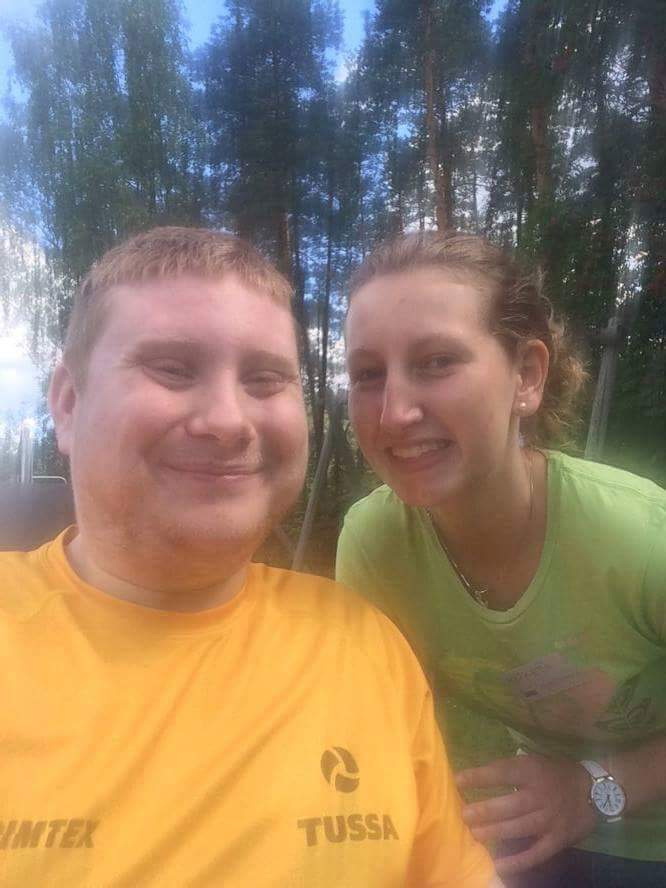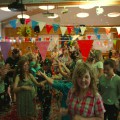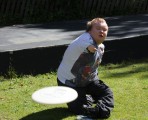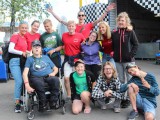Markéta Adamovičová, a third-year student of General Medicine, spent her summer internship in a camp for young people with rare diseases in Frambu, Norway. She writes an essay and sends pictures.

Photo: Archive M. A.
When planning my journey to Frambu, where I was going to work as a helper at a camp for young people with rare diseases, I was looking forward to see in reality what I learned only in theory at Medical Biology lessons. In my mind, I kept repeating the symptoms of various genetic mutations, so that I could see them in the campers. I was wondering whether my knowledge would be sufficient and how many syndromes I would recognize at a first sight.
I didn't have so much information about the program in advance but from the pictures I found online it seemed that various games are being played, people sing at a bonfire, or even swim in a lake or in a pool at the camp. This surprised me a bit, considering the severity of some of the diseases.
I even imagined that the less lucky ones would only lie in their beds most of the time, and all they would do is talking to us or playing cards.
Later, I found out that my expectations had been wrong.
And how did I actually get to Frambu? It was my mom – as a child neurologist, she visited Frambu under the of cooperation with National center for rare diseases at UH Motol funded by Norway Grant projects. She was deeply moved by its philosophy and atmosphere and so I wanted to find out how it moves me.
It was in the middle of July when I finally arrived to Frambu, an area next to a lake in the middle of woods, specifically designed to care for patients with rare diseases and to educate those who carry the mutations, their families and doctors. Frambu is supported by the Norwegian government.
After looking at the program my curiosity kept rising: swimming pool, boats, shooting a movie, concerts, swimming in the lake, football, basketball, show? That sounds like a program for healthy children, not for seriously ill patients! There will be boys with Duchenne, girls with Prader-Willi, DiGeorge, Weaver syndrome, Morquio, several Williams syndrome patients and many more syndromes which I didn't even know... Isn't it too dangerous for them?
Fifty participants aged 14–20 were going to attend the camp. I was one of the 50 helpers. We were divided into five groups, and I was assigned to the black group – the one for the oldest participants, hoping that at least some of them will speak English.
The first day was an organising day – for helpers only. The participants arrived on the second day.
The leader of our group introduced the members of the black group: a 19-years-old boy, who is only about one-metre-tall, is a legend at Frambu, everybody loves him in here. Two boys with Prader-Willi, who behave really well, so there's no need to guard the kitchen at night. They are on a strict diet, which we have to be aware of, but otherwise they are very nice boys. One boy with DiGeorge who is shy, then an 18-years-old girl who has epileptic seizures many times a day, otherwise she's very sweet. A boy with Duchenne who loves Frambu camps, needs help with everything, likes music, plays guitar and piano. A wheelchairer with Weaver syndrome, active, first time at Frambu, another girl on a wheelchair with spina bifida, a 19-years-old girl with XXX who loves sport, and finally a boy with an unknown diagnosis who had never been to Frambu and all we know is that he might have behavioural problems.
The leader reminded us that for the participants, Frambu was often the only place where they don't feel excluded and aren't afraid to talk with others, and that we wanted to make them feel good there. That we should keep in mind that they are teenagers who want to be cool and a part of some group.
‘Wow,’ I thought to myself, ‘that will be interesting’.
And so it was. Next day in the morning the participants started arriving. Three of the members of our group talked in English to me immediately. The girl with spina bifida showed her talent for languages as she even spoke some phrases in Czech to me. The rest of our group pretended not to know English but later it turned out that two more can speak fluently and the others understand either completely or at least partly, so I could spend time without trouble with all of them.
Since I first encountered the participants, I was surprised and amazed how independent they usually were. I expected we would have to help them with everything, but they managed most things by themselves.
In few hours, the hall was full of smiling young people, playing cards, chess or ping-pong, shouting in excitement and hugging old friends.
Some of them were sitting in a wheelchair, some didn't understand the rules of UNO even for the fifth time, others were only humming or waving their hands without control instead of talking. But all of them were satisfied and happy. It was nice to see them like this.
The first day was spent peacefully – getting to know each other, unpacking, playing games and talking, followed by an opening ceremony. In the evening, we met at a bonfire next to a lake. There, a camp tradition took place: every participant wrote their wishes on a piece of paper, the papers were then attached to balloons and those were sent to the sky from the pier.
After that, a concert of a Norwegian singer took place, where I saw how amazing audience Frambu was. All participants and helpers were clapping, shouting, waving their hands in the rhythm. As the concert ended, about a dozen of participants were awaiting the young singer under the stage to take a selfie with her or say a few nice words.
There were three other concerts, one magician and five shows (each prepared by one group) during the camp – and always, the excitement and involvement was visible in the participants' eyes. Most of them usually don't go to concerts – or even onto a stage.
The second day, we went through several activities with the participants: shooting, bowling, basketball, kayak or pedal-boats, and the popular colour fight. Everyone was leaving smiling and very colourful.
For me as an independent observer it was unbelievable how the participants were overcoming the limits of their bodies. The most extraordinary was one boy with SAM syndrome (hands grow from the shoulders and legs are misshapen), who went down from his wheelchair, shuffled to a basketball, strongly grasped it with his legs, then he went to his back, bent himself like a bow and threw the ball to the net – maybe not on his first attempt, but he scored in the end. Later I was honoured to get to know him better and found out that even though he has many challenges in life, he isn't too worried about it and does unbelievable things including singing and drawing.
We experienced really a lot with our group during the first week. Swimming in the lake, jumping off the pier, sailing on boats, shooting videos, playing games, a wonderful team-building game with QR codes and knowledge questions, and most of all: a show, where every one of our participants had a chance to reveal their hidden talents on the stage in front of the others. It was the most touching day for me. A girl with lissencephaly, who usually didn't join common activities for too long because of her frequent seizures, confidently sang a beautiful song on an enlightened stage without a single trouble (only afterwards she had several seizures). A shy Weaver boy enjoyed very much playing drums with his new best (and maybe the only) friend. The boy with an unknown diagnosis owned the stage with playing guitar and singing like a rock star (including running through the audience and giving dozens of high-fives). A ‘shy’ boy with DiGeorge perfectly sang and dramatized a vampire song in Dutch. A girl with spina bifida made everyone laugh with her Icelandic joke. A young man with Morquio syndrome pranked the camp leader in a blind dancing competition, where the camp leader alone was dancing the Duck song at the end and everyone was crying with laughter. Our show was crowned by a 19-year-old boy with Duchenne, who jammed his guitar in a way he could put most of healthy guitar players in his pocket. Every note brought deeper and deeper emotions and in the end, I got goosebumps.
And surely I wasn't the only one.
At the end of the show, when the Frambu song was being played, and everyone who could did get on their feet and danced, I was really proud of all the members of our group. And so were they. For most of them it is unimaginable in their normal lives that so many people clap their hands for them and applaud to them.
Many of the participants were very much looking forward to a disco night. Everyone dressed in their best clothes and went onto a parquet – to talk, drink cocktails, eat popcorn, and – of course – dance. For many of them it was a very special event as it could be the only possibility for many to find a girlfriend/boyfriend.
And again, how amazing atmosphere was there! As if all diseases were gone and all that stayed was a hesitance if asking a girl, they liked for a dance wasn't too risky; or a hope that somebody would notice their nice dress. I felt the same tension as at any other high-school disco I've ever been to.
The first week ended with an event called Kulturkafé, where the participants could join a literature, drawing, dramatic, music or photography programme. That evening, everyone went on the stage and showed their work. Again, many surprised me. The most touching was the literature group, because next to jokes, beautiful poems and deep philosophy, one girl wrote down her story – what problems she had had, how the doctors had told her her diagnosis, and how she (didn't) reconcile with it. Many of the listeners had tears in their eyes as she ended reading, because they heard their own story in hers – and finally they felt like they weren't alone in the world with their problems.
The second week started with what many were waiting for the most of all: the Tusenfryd amusement park!
Everyone who could, hit the carousels, various roller coasters, cars or water attractions. Those who couldn't or were too afraid, bought some candy, enjoyed the sun, and were watching other people, or possibly gambled their money in games and automats. After a day filled with adrenaline everyone was happily remembering how – instead of sitting in a wheelchair – they were flying in the sky or going so fast at roller coasters, satisfied with overcoming their fear of height, or carrying the prices they had won.
A wheelchairer with Weaver syndrome, otherwise always quiet, suddenly excited as a little child, kept talking about everything he experienced at Tusenfryd. It was the best day of his life for him. Parents might have never been brave enough to take him for a roller coaster.
After Tusenfryd, everything went by really fast. We went to the swimming pool with our group – some were just enjoying water or playing cards, threw balls or tried shooting at a goal, others tried to swim as many pools as they could. A boy with an unknown diagnosis swam one kilometre in 25 minutes. Wow. The last evening all swimmers got badges as a reward for their hard work.
The last day arrived sooner than everyone wanted. It was filled with farewells and tears. Nobody wanted to go home. Frambu held everything they needed: fun, people who don't judge them for being different, friends with similar problems, a possibility to show their talents, to talk with the others. They will miss this in their normal lives. Most of them don't have many friends and sit at home most of the time, being bored.
No wonder that Frambu is such an important place for them.
There are so many applications for each camp that they are only allowed to join once in two years.
Two weeks at Frambu not only brought superficial experience to me but also many friends whose stories made me think more about myself, about life and death, suffering of the sick, importance of research and about choosing the right attitude to young patients.
They don't want to be treated as patients. They don't want us to look at them like that. They want to enjoy activities, discuss their hobbies, show their talents. Despite the illness they are facing, their priorities stay the same as in healthy teenagers: they want to be cool, have friends, be part of a group, beat the odds, learn new things, plan their future, find the love of their life.
Let's not forget that under the labels of various syndromes, many individuals are hidden who long to be noticed. Let's focus more on the possibilities rather than on limitations given by the syndromes.
The life of these young people doesn't end when being diagnosed!
Therefore, let's support them so that they could live rich and worthy lives and keep growing as individuals even though a severe disease has entered their lives.




